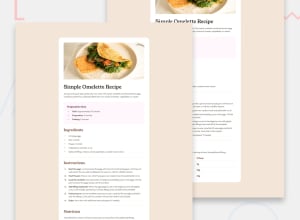
Design comparison
Solution retrospective
What I'm proud of is that I finished it even though I faced a lot of challenge on how to make it more similar to the original and most especially the difficulty of typography and responsiveness. What I would do next time is to make it more very similar to the original like the font sizes, responsiveness and color palettes.
What challenges did you encounter, and how did you overcome them?The challenges I encountered included how to use a global font-family, specifically with the root selector. I found it very helpful, but I didn’t use it due to a lack of study on the subject. It was also challenging for me to handle box-sizing, including padding, margins, and centering a container. However, with the help of Stack Overflow, YouTube, and ChatGPT, I was able to overcome these challenges.
What specific areas of your project would you like help with?I need some advice on how to study CSS designs, is it mandatory to master it? Because I'm really bad at designing like UI's and everything.
Community feedback
- @StroudyPosted 2 months ago
- Wrapping a
<img>in a<div>is unnecessary,
<div class="hero-img"> <img src="images/image-omelette.jpeg" alt="omellete-img" /> </div>-
Using
max-width: 100%ormin-width: 100%is more responsive than justwidth: 100%because they allow elements to adjust better to different screen sizes. To learn more, check out this article: responsive-meaning. -
Developers should avoid using pixels (
px) because they are a fixed size and don't scale well on different devices. Instead, useremorem, which are relative units that adjust based on user settings, making your design more flexible, responsive, and accessible. For more information check out this, Why font-size must NEVER be in pixels or this video by Kevin Powell CSS em and rem explained.- Another great resource for px to rem converter. -
For future project, You could downloading and host your own fonts using
@font-faceimproves website performance by reducing external requests, provides more control over font usage, ensures consistency across browsers, enhances offline availability, and avoids potential issues if third-party font services become unavailable. -
I think you can benefit from using a naming convention like BEM (Block, Element, Modifier) is beneficial because it makes your CSS more organized, readable, and easier to maintain. BEM helps you clearly understand the purpose of each class, avoid naming conflicts, and create reusable components, leading to a more scalable codebase. For more details BEM,
You’re doing fantastic! I hope these tips help you as you continue your coding journey. Stay curious and keep experimenting—every challenge is an opportunity to learn. Have fun, and keep coding with confidence! 🌟
1@arnoldpam11Posted 2 months agoThank you so much for your advices. I really appreciate it!@Stroudy
1 - Wrapping a
Please log in to post a comment
Log in with GitHubJoin our Discord community
Join thousands of Frontend Mentor community members taking the challenges, sharing resources, helping each other, and chatting about all things front-end!
Join our Discord
